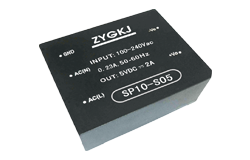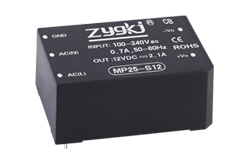news
Design of an AC-DC Converter Circuit
Author: ZYG Power Module Time: 2023-4-28
An AC-DC converter circuit is a device that converts alternating current (AC) to direct current (DC). It is an essential component of many electronic devices, including power supplies, computers, and telecommunications equipment.
The design of an AC-DC converter circuit involves several key components, including a transformer, rectifier, filter, and voltage regulator. These components work together to convert the AC input voltage into a stable DC output voltage that can be used to power electronic devices.
The transformer is the first component in the AC-DC converter circuit. It is used to step down the high voltage AC input to a lower voltage that can be rectified and filtered. The transformer consists of two coils of wire wound around a magnetic core. The primary coil is connected to the AC input voltage, while the secondary coil is connected to the rectifier circuit.
The rectifier is the second component in the AC-DC converter circuit. It is used to convert the AC input voltage into a pulsating DC voltage. There are two types of rectifiers: half-wave rectifiers and full-wave rectifiers. Half-wave rectifiers are simpler and more economical, but they produce a lower DC output voltage. Full-wave rectifiers are more complex and expensive, but they produce a higher DC output voltage.
The filter is the third component in the AC-DC converter circuit. It is used to smooth out the pulsating DC voltage produced by the rectifier. The filter consists of a capacitor and a resistor connected in parallel. The capacitor stores electrical energy and releases it in a steady stream, while the resistor limits the flow of current.
The voltage regulator is the final component in the AC-DC converter circuit. It is used to maintain a stable DC output voltage regardless of changes in the AC input voltage or load. There are two types of voltage regulators: linear regulators and switching regulators. Linear regulators are simpler and more economical, but they produce a lot of heat. Switching regulators are more complex and expensive, but they are more efficient and produce less heat.
In conclusion, the design of an AC-DC converter circuit involves several key components that work together to convert AC input voltage into stable DC output voltage. These components include a transformer, rectifier, filter, and voltage regulator. The selection of these components depends on the specific requirements of the electronic device being powered.
Previous: Title: Industrial AC-DC Converter for Efficient Power Conversion
Next: Industrial AC-DC Converter: Efficient and Reliable Power Conversion
relevant information
-
2023-9-14
Efficient and Flexible: Introducing the 850 Watt Modular Power Supply
In today's fast-paced and technology-driven world, having a reliable and efficient power supply is crucial for any electronic device. Whether you are a gamer, a content creator, or a professional working on complex projects, a high-quality power supply can make all the difference in maintaining stable and consistent performance. Introducing the 850 Watt Modular Power Supply, a game-changer in the world of power supplies. Efficiency is at the heart of the 850 Watt Modular Power Supply. With its advanced design and cutting-edge technology, this power supply boasts an impressive efficiency rating of 90%. This means that it wastes less energy during the power conversion process, resulting in lower electricity bills and reduced environmental impact. Say goodbye to inefficient power supplies...
View details -
2023-10-30
DC-DC Power Supply Module: Efficient and Reliable Power Solution
In today's technologically advanced world, power supply plays a crucial role in ensuring the smooth operation of various electronic devices. One such power solution that has gained significant popularity is the DC-DC power supply module. This module is known for its efficiency and reliability, making it an ideal choice for numerous applications across various industries. The DC-DC power supply module is designed to convert one DC voltage level to another, ensuring that electronic devices receive the appropriate power they require to function optimally. This module is widely used in industries such as telecommunications, automotive, aerospace, and consumer electronics, where efficient power supply is critical. One of the key advantages of the DC-DC power supply module is its high efficiency. Unlike...
View details -
2023-5-3
AC-DC Converter Circuit: Design and Implementation
AC-DC Converter Circuit: Design and ImplementationAn AC-DC converter circuit is a device that converts alternating current (AC) to direct current (DC). This type of circuit is commonly used in electronic devices to provide power for their internal components. In this article, we will discuss the design and implementation of an AC-DC converter circuit.DesignThe first step in designing an AC-DC converter circuit is to determine the requirements of the circuit. This includes the input voltage and frequency, output voltage and current, and any other specifications that are required for the specific application.Once the requirements have been determined, the next step is to choose the appropriate circuit topology. There are several different topologies that can be used for an AC-DC converter circuit,...
View details -
2023-10-19
AC/DC Power Supply Module: A Reliable Solution for Stable Power Output
Introduction: In today's technologically advanced world, power supply plays a crucial role in ensuring the smooth functioning of various electronic devices. From smartphones to computers, every device requires a stable power supply to operate efficiently. One such reliable solution for stable power output is the AC/DC Power Supply Module. This article will delve into the features, benefits, and applications of this module, highlighting why it is an ideal choice for various industries. Features of AC/DC Power Supply Module: 1. Stable Power Output: The AC/DC Power Supply Module is designed to deliver a stable power output, ensuring that electronic devices receive the required voltage without any fluctuations. This stability prevents damage to sensitive components and ensures consistent performance. 2. Wide Input...
View details -
2023-10-20
Modular vs Non-Modular Power Supply: Which Is Right for You?
When it comes to building or upgrading a computer, one of the most important components to consider is the power supply unit (PSU). The PSU is responsible for converting AC power from the wall outlet to DC power that the computer can use. It provides the necessary power to all the components, including the CPU, GPU, and storage devices. However, when it comes to choosing a PSU, there is a crucial decision to make: modular or non-modular. A modular power supply is one where the cables can be detached from the unit, allowing for a customizable cable management system. This means that you can connect only the cables you need for your specific build, reducing cable clutter and improving airflow...
View details -
2023-12-5
High Voltage Power Supply Module: Delivering Reliable and Efficient Electrical Energy
In today's modern world, the demand for electrical energy is constantly increasing. Industries and households rely heavily on electricity to power their operations and daily activities. To meet this demand, high voltage power supply modules have become an essential component of power distribution systems. These modules play a crucial role in delivering reliable and efficient electrical energy to various applications. This article will explore the importance of high voltage power supply modules and their impact on our daily lives. High Voltage Power Supply Modules: Key Features A high voltage power supply module is designed to convert the input voltage into a higher output voltage, typically ranging from hundreds to thousands of volts. These modules are compact in size and offer...
View details


















